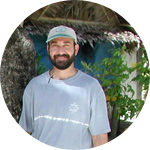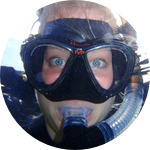About This Project
There is more algae on coral reefs than ever before and humans are to blame. Can we use next generation techniques to play "Dr. Doolittle" and find out just how the coral animals feel about living in contact with algae? We know that some algae can kill coral in the lab, but we also know that algae and coral can grow next to each other on the reef seemingly unaffected. What hidden effect is algae having on coral? How will that impact the way we survey and manage coral reefs to preserve them?
Ask the Scientists
Join The DiscussionWhat is the context of this research?
Coral reefs provide essential habitat for fish, contribute to coastal security, and provide millions of dollars in tourism revenue. But those services are dependent on having coral. Overfishing and nutrification of coastal waters means fewer herbivores grazing faster-growing algae, resulting in more algae on coral reefs. Research tells us this means decreased coral growth and reproduction. But often corals in contact with algae on the reef do not appear unhealthy. The rise of cost-effective next-generation sequencing methods allows me to be a coral "Dr. Doolittle," asking apparently healthy corals how they really feel about being in direct contact with the invasive macro alga, "Gorilla Ogo," and whether different species of coral feel differently about their neighbor.
What is the significance of this project?
The future of coral reefs depends on our ability to monitor reef health and respond with effective management. While traditional coral reef monitoring has been successful at documenting the decline of coral reefs in response to multiple stressors, the point at which a coral can be visually identified as “stressed” is beyond the point at which management can be effective to remove the stressor. The use of next-generation and molecular methods allows us to be “coral whisperers” and detect stress in corals before they appear stressed visually. Applying these techniques to coral-algae interactions will allow us to understand more fully how algae affect corals, and how management options can be tailored to specific areas to support the survival of coral reefs.
What are the goals of the project?
300 coral nubbins were collected in March of this year, from three different common species of coral (see lab notes!). Nubbins were placed in direct contact with mats of the invasive alga, Gorilla Ogo, for 1-3 months (check out "results" tab for preliminary results!).
I will apply a cutting-edge technology called tag-based RNA sequencing to identify which genes are expressed in Lobe Corals that have been in contact with Gorilla Ogo, and which molecular pathways (oxidative stress, detoxification, etc) are involved in that stress response, which will tell me how the coral animal is affected by this stressor.
My goal for this project is to sequence RNA from 4 different treatments (1,2,3 month exposures + control) for each of 22 Lobe Coral colonies.
Budget
The money raised here will be used for laboratory processing and RNA sequencing of lobe coral samples for gene expression analysis. This will let me be a "coral whisperer" and understand how coral is affected by contact with algae. This sequencing is essential to making future comparisons between responses of different coral species as well.
Next generation sequencing is expensive, but I have cut down the cost significantly by embracing a new method called tag-based RNA sequencing, which gives highly accurate gene expression data at a fraction of the cost. With this cost-effective method, the per-sample cost of full laboratory preparation and sequencing is only $50.
At minimum I need to sequence the control corals (no contact with algae) and those that have been in contact with algae for a full 3 months.
Every time point requires sequencing 22 samples, so with every $1100 I can sequence one time point (1, 2, 3 month exposures + control).
Endorsed by
Meet the Team
Tori Sindorf
The first time I plunged my masked face into the ocean, I was hooked. I bobbed upside down as long as I could on one breath, staring corals right in the polyp. I never wanted to look away. I still don't!
I've always been passionate about the natural world and our role in protecting and conserving it, so I was naturally drawn to science. I spent my undergraduate years doing wildlife ecology in Michigan, coral community surveys in Mexico, and studying green algae blooms in Washington.
Now as a PhD student in Hawaii I am a devoted coral nerd, doing research aimed at practical coral reef conservation applications with the hope that I can make some small contribution towards my grandchildren and great grandchildren being able to stick their own masked faces into coral reefs.
Additional Information
The budget for this project, $2200 represents the bare minimum - sequencing one time point and the control samples. After we hit that, I will start adding "stretch goals," and every additional $1100 will allow me to sequence one more treatment. I have a total of 4 "treatments," including the control, so my full budget is actually $4400, and I can add in a bonus "recovery" treatment if I reach $5500!
For more information about this project, check out the lab notes!
For more information about me, check out my website, ToriSindorf.com.
All contributors will receive regular updates about the project and a copy of forthcoming publications.
Contributions of $50 will pay for 1 sample to be processed and sequenced, and contributors will receive a unique "heart for the sea" pendant necklace or keychain as a thank you.
Contributions of $1100 will pay for the processing and sequencing of all 22 samples for one treatment, and contributors will be personally acknowledged in forthcoming publications.
Project Backers
- 53Backers
- 105%Funded
- $2,323Total Donations
- $43.02Average Donation


